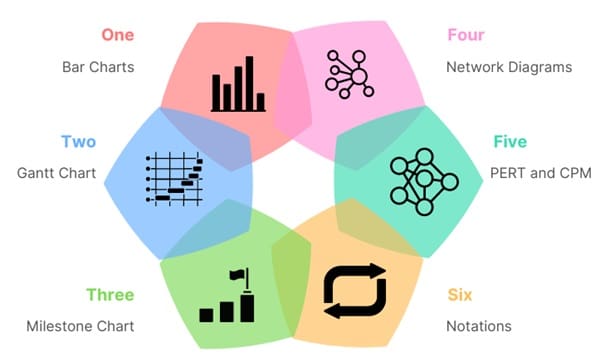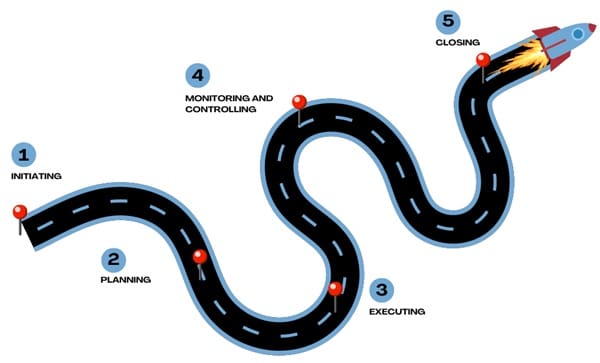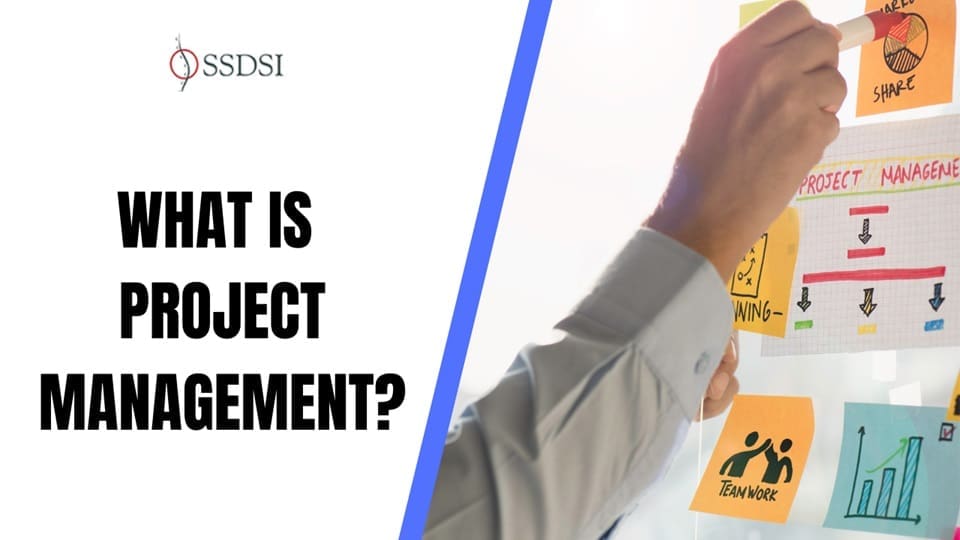Project management is a systematic approach to planning, organizing, coordinating, and monitoring a series of related activities to achieve specific goals within a set timeframe.
At its core, effective project management enables project managers to use various tools and techniques to create robust initial plans and adapt quickly to any deviations, ensuring that necessary adjustments can be made.
Table of contents
What is Project Management?
Project management is the practice of initiating, planning, executing, controlling, and closing the work of a team to achieve specific goals within a designated timeframe.
The main challenge in project management is to meet all project objectives while adhering to constraints, which are typically defined at the start of the project. These constraints usually include scope, time, quality, and budget.
Successful project management also seeks to optimize resource allocation and apply these resources effectively to achieve predefined objectives.
Key Features
- Project Manager: The individual responsible for overseeing the project from start to finish, ensuring all tasks are completed on time and within budget.
- Project Team: A group of individuals with diverse skills who work together to achieve project objectives.
- Project Management System: This encompasses the organizational structure, information processing, and decision-making processes that facilitate integration and control of project activities.
Objectives
The primary objectives of project management can be categorized as follows:
- Scope: Clearly defined project deliverables and expectations.
- Performance: Meeting quality and performance standards.
- Time: Completing the project within the planned timeframe.
- Cost: Managing expenditures in relation to performance, time, and scope.
Using the SMART criteria, project goals should be Specific, Measurable, Attainable, Realistic, and Time-bound.
Benefits
- Handling Complexity: Project management is particularly effective for complex and costly projects, such as those in research and development (R&D) or capital goods manufacturing.
- Time-Bound Tasks: It allows teams to manage assignments with specific start and end dates, helping industries track customer orders effectively.
- Task Orientation: It provides clear roles and responsibilities for team members, making it easier to manage tasks within organizations, especially in sectors like IT.
Project Identification and Formulation
Importance of Project Identification
Identifying a project is crucial because it ensures alignment with market needs and resource exploitation. Many projects arise from national planning efforts, while commercial opportunities drive others.
Steps in Project Formulation

- Opportunity Studies: Assess potential investment opportunities at a macro level.
- Pre-Feasibility Study: Evaluate the viability of a project idea through preliminary research on market demand, technical feasibility, and financial implications.
- Feasibility Study: This in-depth analysis examines all aspects of a project, from economic viability to environmental impact.
- Project Appraisal: Review the feasibility study and make decisions about moving forward.
- Detailed Project Report: A comprehensive document that outlines the project’s objectives, methods, and expected outcomes.
Components of Feasibility Studies
- Economic Analysis: Understanding market trends, competition, and customer needs to assess the project’s viability.
- Technical Analysis: Evaluating technology options and resource requirements to determine the best approach for the project.
- Financial Analysis: Using methods like Net Present Value (NPV) and Return on Investment (ROI) to assess financial viability.
- Risk Analysis: Identifying potential risks and uncertainties that could affect project success.
Project Management Techniques

Bar Charts
Bar charts visually represent tasks needed to complete a project. They are essential for tracking progress and scheduling.
Gantt Chart
Developed by Henry L. Gantt in the early 20th century, this chart displays tasks along a timeline. Each task is represented by a horizontal bar, showing its start and finish dates. While Gantt charts are user-friendly, they struggle with complex projects and don’t illustrate task interdependencies.
Milestone Chart
This chart builds on the Gantt chart by adding milestones—key events marking the completion of significant phases. Although it helps track progress, it still doesn’t convey interdependencies between tasks effectively.
Network Diagrams
Network diagrams illustrate the interrelationships among project activities, offering a more comprehensive view of project timelines.
PERT and CPM
- Program Evaluation and Review Technique (PERT): Focuses on scheduling and monitoring activities where time estimates are probabilistic.
- Critical Path Method (CPM): Used primarily for resource optimization with deterministic time estimates.
Both techniques visualize project workflows, with activities represented by arrows and events by nodes (or circles).
Notations
- Activity-on-Arrow (AOA): Arrows depict activities, while circles represent events.
- Activity-on-Node (AON): Boxes show tasks, and arrows indicate their sequence.
Importance of Project Management

Here are several compelling reasons why project management is essential in today’s dynamic environment.
1. Reducing Product Life Cycle
As products evolve, their life cycles shorten significantly. In this fast-paced market, getting new products to market quickly is crucial. Organizations depend on cross-functional project teams to innovate and expedite the development process.
2. Navigating Global Competition
In today’s global marketplace, customers demand high-quality products at lower prices. This expectation drives a focus on quality management, which forms a core component of project management. By concentrating on time, cost, and quality, project managers help organizations meet customer demands while remaining competitive.
3. Managing Knowledge Explosion
The rapid increase in available knowledge complicates project management. Modern products often require integrating diverse technologies and expertise.
4. Addressing Corporate Downsizing
Recent years have seen many organizations restructure, leading to downsizing and a focus on core competencies. In this environment, effective project management becomes increasingly important, as companies must optimize resources and deliver results under tighter constraints.
5. Enhancing Customer Focus
As competition intensifies, customers expect more personalized products and services. Project teams must develop a deeper understanding of customer needs to deliver tailored solutions.
6. Managing Small Projects
Organizations often juggle multiple projects simultaneously, resulting in a complex project environment. Effective project management ensures that resources are prioritized appropriately, even for small projects. While these smaller initiatives may seem less impactful, their inefficiencies can accumulate and lead to significant costs.
Therefore, project management is critical to addressing both small and large projects effectively.
7. Tapping into Emerging Markets
The gradual opening of third-world and previously closed economies has created new markets for goods and services. As businesses expand into these regions, project management techniques become essential for establishing operations and creating distribution channels efficiently.
Project Management Process

Project management follows a structured approach that can be broken down into several key phases. Each phase plays a crucial role in ensuring successful project execution.
1. Initiating
The initiation phase defines the project and secures authorization to start. This involves creating a Project Charter, which outlines the project scope and identifies stakeholders. By clearly defining the project’s purpose and objectives, the initiation phase sets the stage for success.
2. Planning
Planning is perhaps the most critical phase in project management. It involves developing a comprehensive Project Management Plan that serves as a roadmap for execution. During this phase, project managers establish clear objectives, define project scope, and identify the resources needed.
The planning phase also includes risk assessment and the development of strategies for effective communication and stakeholder management.
Effective planning requires thorough documentation. Project managers create plans that detail timelines, budgets, quality requirements, and procurement strategies. This roadmap not only guides the execution phase but also provides a basis for monitoring and controlling project progress.
3. Executing
During the execution phase, project teams carry out the planned activities to produce deliverables. This phase requires effective coordination among team members and the management of resources to meet project goals. Clear communication is vital to ensure that everyone understands their roles and responsibilities.
Quality control measures are also crucial during execution. Project managers implement standards and processes to monitor the quality of work, ensuring that deliverables meet the defined specifications. This phase often consumes the most resources and time, making it essential to maintain focus and direction.
4. Monitoring and Controlling
Monitoring and controlling occur simultaneously with execution. This phase involves tracking progress against the Project Management Plan and identifying any deviations. Project managers use various tools and techniques to measure performance and ensure that the project stays on track.
If discrepancies arise, project managers make adjustments to align activities with the planned objectives. This proactive approach helps manage risks and ensures that any issues are addressed promptly. Regular status reports and meetings keep stakeholders informed and engaged throughout the process.
5. Closing
The closing phase formalizes the conclusion of the project. It includes finalizing all activities, delivering the completed product or service to the client, and communicating the project’s closure to stakeholders. This phase also provides an opportunity for reflection, allowing teams to evaluate what went well and what could be improved for future projects.
During closing, project managers compile documentation and lessons learned, creating a knowledge base for future endeavors. This reflective process fosters continuous improvement within the organization, enhancing its project management capabilities over time.
Challenges in Project Management

While project management is vital, it is not without challenges. Project managers face various obstacles that can hinder project success. Here are some common challenges:
1. Scope Creep
Scope creep occurs when the project’s scope expands beyond its original boundaries. This often happens due to changing stakeholder requirements or a lack of clear project goals. To manage scope creep, project managers must maintain strict control over project changes and ensure that all modifications are documented and approved.
2. Resource Constraints
Limited resources can pose significant challenges to project management. Whether it’s financial, human, or technological resources, project managers must allocate resources effectively to avoid delays and maintain project quality. Balancing resource allocation across multiple projects is also a common challenge in multi-project environments.
3. Risk Management
Projects inherently involve risks, and effective risk management is crucial for success. Project managers must identify potential risks early in the project and develop mitigation strategies. Failure to address risks can lead to delays, budget overruns, and compromised quality.
4. Stakeholder Management
Managing stakeholder expectations can be complex. Different stakeholders may have competing interests and priorities, making it essential for project managers to communicate effectively and build consensus. Regular engagement with stakeholders helps align their expectations and fosters collaboration.
5. Adapting to Change
Change is a constant in project management. Whether due to market shifts, technological advancements, or organizational restructuring, project managers must be adaptable. Embracing change and being open to new approaches can enhance project outcomes and ensure alignment with evolving business goals.
Final Words
Project management is a vital discipline that combines structured planning, coordination, and control to navigate the complexities of modern projects. By utilizing various techniques like Gantt charts, milestone charts, and network diagrams, project managers can effectively manage scope, performance, time, and costs.
As organizations face increasing pressures from technological advancements, globalization, and customer demands, the importance of effective project management continues to grow, helping businesses succeed in an ever-changing landscape.

About Six Sigma Development Solutions, Inc.
Six Sigma Development Solutions, Inc. offers onsite, public, and virtual Lean Six Sigma certification training. We are an Accredited Training Organization by the IASSC (International Association of Six Sigma Certification). We offer Lean Six Sigma Green Belt, Black Belt, and Yellow Belt, as well as LEAN certifications.
Book a Call and Let us know how we can help meet your training needs.



















